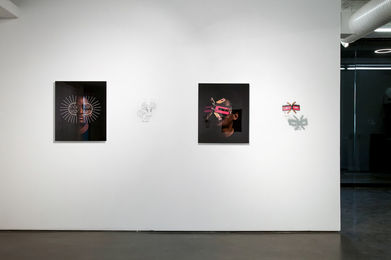CYRUS KABIRU
Macho Mbadala
EXHIBITION TEXT
Solo Exhibition
10.06.17 – 01.07.17
Johannesburg
Macho Mbadala by Cyrus Kabiru is the internationally acclaimed Kenyan artist’s second solo exhibition with the gallery. Kabiru is best known for his elaborate and detailed sculptural spectacles or C-Stunners, constructed from urban debris.
This series of work presents thirteen new C-Stunners, each complemented by a unique photographic portrait of the artist modelling his distinctive creations.
In this exhibition, the artist has chosen to produce his portraits in a unique edition – allowing for only one image to be released to accompany each pair of C-Stunners. Each single photographic release works symbiotically as one piece with its C-Stunner counterpart, challenging the notion of the photograph as endlessly reproducible. Here, photography and sculpture form what seems to be an unlikely alliance; however, since the photograph’s conception, the two have been inseparable. Be it a bitumen-coated plate or a memory card, photography is often our primary medium to communicate and digest sculpture, constantly transforming how we perceive and value the three-dimensional artwork and – in this case – becoming a collectable artwork in its own right.
Visibly maturing over the past decade, and innovatively incorporating cast-offs both man-made and natural, the C-Stunners evoke discourse around ways of seeing and being seen. In their materiality, these mask-like glasses are products of, and reflective upon, a world where identities are forged through the buying and discarding of commodities. Like El Anatsui’s bottle-top tapestries, Kabiru’s sculptural works are constructed using waste material and found objects, including discarded and obsolete technology. “The place where I grew up faced the Nairobi dump site,” says the artist. “All the trash, all the waste of Nairobi, used to be dumped in my neighborhood. So whenever I woke up, the first thing I saw was garbage. I used to tell my [father] I would like to give trash a second chance. I would like to work with trash. And that’s why, up to now, that’s what I’ve done.”
Often covering the artist’s entire face, there is a performative element to the way in which Kabiru wears his C-Stunners that can be linked to a re-invention of contemporary mask-making – a characteristic employed by artists such as Romuald Hazoumè and Gonçalo Mabunda. However, Kabiru didn’t set out to appropriate the mask as a vehicle for meaning. Rather, his interest in these one-off spectacles that intricately frame and sometimes disguise the face began as a childhood hobby. At about seven years old, Kabiru admired his father and other figures in the community who wore eye glasses, and was eager to have a pair of his own. His father said to him, “Cyrus, if you want to wear the glasses, maybe make your own glasses.” Thus, the C-Stunners were born.
Individually, each creation in this series bears its own story, and abounds with personality. The use of cowry shells, for example, suggest the medium of exchange similar to money that was used across Africa and other continents. Alternatively, this and the use of buttons and jewellery trinkets also touch on means of personal adornment. These items, referencing historic traditions, are juxtaposed against modern man-made objects – suggesting the merger of cultures, beliefs and assumption into something new.
Also featuring in Macho Mbadala is one of Kabiru’s Black Mambas – the artist’s deconstructed and reimagined version of the fixed gear bicycles that have achieved an iconic status in his home country and the central African region. The Black Mamba itself becomes a distinctive sculptural construction, celebrating the bicycle’s form and (non)function.
Kabiru’s artistic career began in Nairobi, the place of his first solo show, which was held in 2008. He has since gained a global reputation. His art practice developed in the context of expanding spaces for contemporary art production, distribution and reception – both within Kenya and worldwide. Throughout this period, and within the multifaceted metropolis of Nairobi, Kabiru’s self-assertion, rebel nature, rejection of institutional instruction, and globally acclaimed artwork epitomise the macro shift in discourse about artists from Kenya and indeed the continent.
Kabiru is a storyteller, whose narratives are told through these aesthetic assemblages, created through the manipulation of urban debris. His artworks intrinsically connect with concepts of existence by drawing upon childhood curiosities, concerns of the present and future, the city, and the things that encompass these.












































